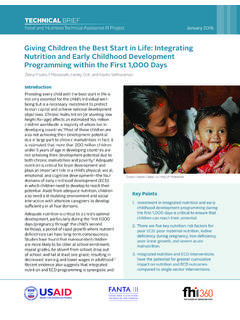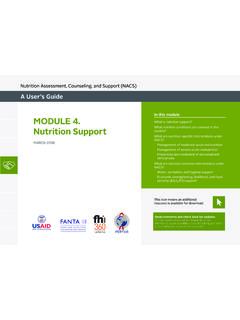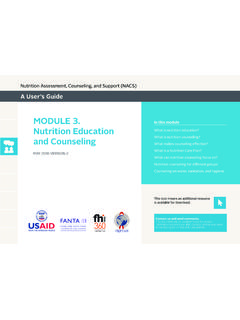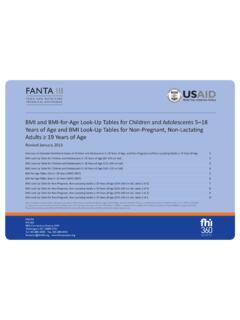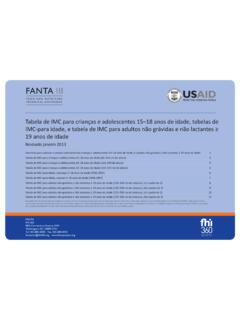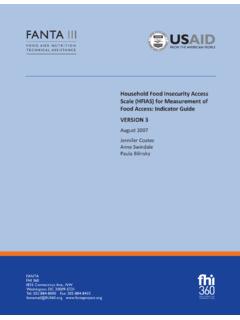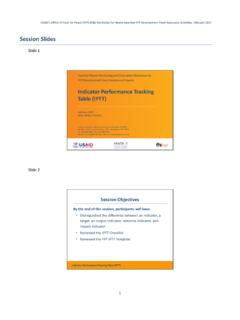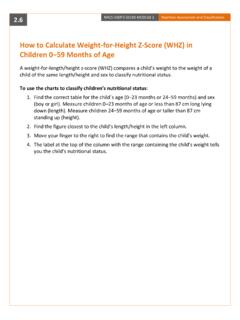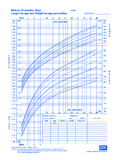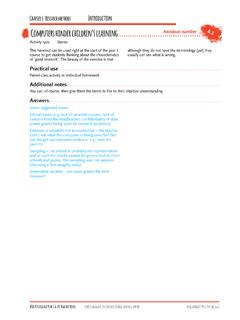Transcription of Why is nutrition assessment important? Nutrition Assessment
1 FANTAIIIFOOD AND NUTRITIONTECHNICAL A SSISTANCEPEPFARN utrition Assessment , Counseling, and Support (NACS)A User s GuideMODULE 2. Nutrition Assessment and ClassificationMAY 2016 VERSION 2In this moduleWhat is Nutrition Assessment ?Why is Nutrition Assessment important? What is Nutrition screening?If health care providers can't assess every client's nutritional status, which clients should they prioritize?How often should Nutrition Assessment be done?What are the different kinds of Nutrition Assessment ? Anthropometric Assessment Biochemical Assessment Clinical Assessment Dietary Assessment Food security assessmentThis icon indicates that an additional resource is available for download.
2 Contact us and send document will be updated frequently as new information becomes available. Consider adding your name to our mailing list to receive future updates. 2 Nutrition Assessment and ClassificationIntroductionNACS USER S GUIDE MODULE 2, VERSION 2 What is Nutrition Assessment ? Nutrition Assessment includes taking anthropometric measurements and collecting information about a client s medical history, clinical and biochemical characteristics, dietary practices, current treatment, and food security situation.
3 Why is Nutrition Assessment important? Optimal nutritional status the state of the body with respect to each nutrient and overall body weight and condition is a powerful factor in promoting health and preventing and treating diseases. Weight loss of 10 percent or more has been associated with adverse outcomes and prolonged hospitalization, and in lean, healthy people, weight loss of more than 35 percent has been associated with Nutritional status affects immune response and response to medical therapies.
4 Health care providers assess clients nutritional status for many reasons: yTo identify people at risk of malnutrition for early intervention or referral before they become malnourished yTo identify malnourished clients for treatment malnourished people who are not treated early have longer hospital stays, slower recovery from infection and complications, and higher morbidity and mortality yTo track child growth yTo identify medical complications that affect the body s ability to digest food and utilize nutrients yTo detect practices that can increase the risk of malnutrition and infection yTo inform Nutrition education and counseling yTo establish appropriate Nutrition care plansThe results of a client s Nutrition Assessment and classification of nutritional status determine all the other elements of Nutrition Assessment , counseling.
5 And support (NACS) for that individual including counseling, treatment, and referral to food security and other is Nutrition screening?Full Nutrition Assessment can be preceded by rapid and simple identification of people who may be malnourished or at risk of malnutrition and need more detailed Nutrition Assessment . Nutritionists and trained facility-based health care providers or community service providers can do Nutrition screening in health care facilities, during growth monitoring or home-based care, and during support group meetings.
6 Simple Nutrition screening can include checking for bilateral pitting edema, measuring weight and mid-upper arm circumference (MUAC), and asking about recent illnesses and appetite. Nutrition screening requires standardized training in line with national and local health policy. Special training materials may be needed for low-literacy or illiterate populations. Community service providers need government-approved recording and referral materials, and clear guidance on provider roles, whom to screen, 1 Feldman, M.
7 ; Friedman, L.; and Brandt, L. 2010. Sleisenger and Fordtran s Gastrointestinal and Liver Disease: Pathophysiology, Diagnosis, Management. 9th edition. Philadelphia: Saunders. Chapter 4. Sample Nutrition screening toolsNACS glossary Send a comment or check for new versions 3 Nutrition Assessment and ClassificationOverviewNACS USER S GUIDE MODULE 2, VERSION 2how, and how often. They may also need incentives to do accurate and consistent community Nutrition screening and make health care providers can t assess every client s nutritional status, what clients should they prioritize?
8 1. Children under 2 years of age, especially if they are not breastfed2. Women who are pregnant or up to 6 months postpartum3. People who report unintentional weight loss4. People who have been prescribed specialized food products to treat malnutrition5. People with disease-related symptoms that can be managed through diet6. People with HIV, tuberculosis (TB), or other chronic diseasesHow often should Nutrition Assessment be done? The frequency of Nutrition Assessment depends on a client s age and pregnancy and disease status and on national policies.
9 The recommendations below should be adjusted based on national guidelines. yPregnant/postpartum women: On every antenatal visit yInfants 0 < 6 months of age: At birth and on every scheduled postnatal visit yInfants 6 59 months of age: During monthly growth monitoring sessions for children under 2 and every 3 months for older children yChildren 5 years of age and over: On every clinic visit yAdolescents and adults: On every clinic visit yPeople with HIV: On every clinic visit and when initiating or changing antiretroviral therapy (ART) What are the different types of Nutrition Assessment ?
10 An easy way to remember types of Nutrition Assessment is ABCD: Anthropometric, biochemical, clinical, and dietary. Send a comment or check for new versions 4 Nutrition Assessment and ClassificationAnthropometric AssessmentNACS USER S GUIDE MODULE 2, VERSION 2 Anthropometry is the measurement of the size, weight, and proportions of the body. Common anthropometric measurements include weight, height, MUAC, head circumference , and skinfold. Body mass index (BMI) and weight-for-height are anthropometric measurements presented as indexes.
